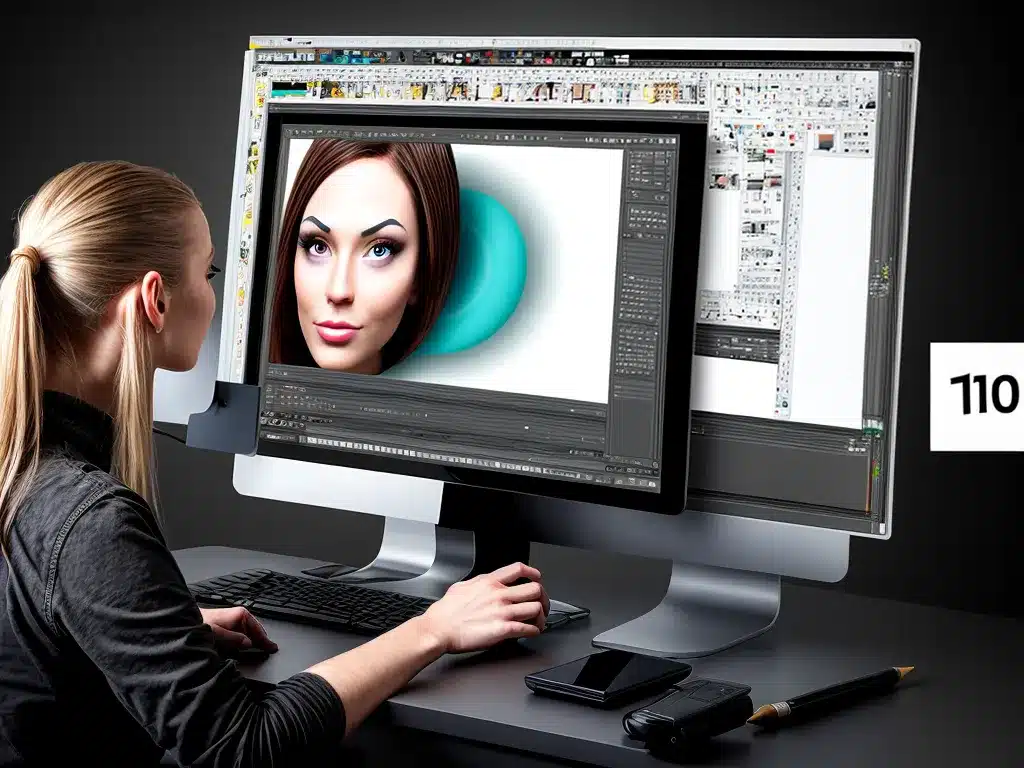As a graphic designer in 2024, mastering Photoshop will be essential for creating stunning visuals and designs. With new features and updates added constantly, there are many tips and tricks to learn. Here are my top 10 Photoshop tips to help graphic designers streamline their workflows and take their skills to the next level in 2024:
1. Use Layer Comps for Quick Design Iterations
Layer comps allow you to capture the state of layers to easily switch between variations of a design. Here’s how I use them:
- Create initial design and layout elements on separate layers
- Make copies of layers for alternate versions
- Define layer comps for each desired design iteration
- Quickly enable/disable layers to switch between comps
This saves me tons of time compared to duplicating the file itself. I can swiftly visualize how small tweaks impact the overall design.
2. Customize Brush Presets
Photoshop comes loaded with brush presets, but customizing your own is key for productivity. I optimize brushes for my specific workflow:
- Adjust size, hardness, spacing for canvas needs
- Shape dynamics for angled, textured strokes
- Dual brushes for two tones
- Scatter for organic, grungy effects
Saving these as presets means I can instantly access my ideal brushes for any project.
3. Convert Text to Outlines
When I want to manipulate text like shapes in a design, converting it outlines is a must. This locks down the fonts and words into vector shapes for full control. Benefits include:
- Resize/scale text without quality loss
- Alter individual letters or join text together
- Change color/gradients of letterforms
- Animate or morph outlined text
Just be sure to keep the original text layer for editing!
4. Use Smart Objects for Non-Destructive Editing
I love using smart objects to keep my edits non-destructive. With traditional layers, changes directly alter the pixels. Smart objects allow me to:
- Edit contents non-destructively, even later
- Experiment freely without damaging source
- Resize/transform contents independently
- Easily update linked smart objects
They’re fantastic for working with vector assets or preserving perfect typesetting when playing with effects.
5. Load Selections as Masks
Utilizing masks is crucial for graphic design work in Photoshop. An easy way to mask off areas is by loading selections as masks. My process:
- Make selection with any tools (lasso, color range, etc)
- Right click selection outline
- Choose “Load selection as mask”
- Mask hides/reveals selected area
I can then refine the mask edges, change density for a soft edge, apply it to groups/layers, and more. Very handy!
6. Use Camera Raw as a Filter
The powerful editing tools in Camera Raw go way beyond just processing photos. I use it as a filter on any layer or smart object for advanced color correction, curves, haze removal, vignettes, grain, and much more. Key benefits:
- Non-destructive workflow
- Parameters don’t degrade image quality
- Selectively apply to specific areas
- Intuitive sliders for targeted adjustments
- Save settings as presets for reuse
It provides me incredible flexibility when retouching, compositing, and fine-tuning designs.
7. Create Global Lighting Effects
The Lighting Effects filter lets you easily adjust image lighting with naturalistic light sources. For graphic work, I use it to:
- Establish mood and drama
- Draw attention to specific focal points
- Mimic studio lighting setups
- Create fake shadows, highlights, reflections
- Make 3D renders or flat graphics look more photorealistic
With a little creativity, Lighting Effects can drastically enhance an image or design!
8. Build Custom Brush Stamp Patterns
Photoshop’s Brush tool lets you define custom brush tips using any images, shapes, or patterns. As a designer, I build unique brush stamp sets to speed up my workflow such as:
- Highly specific abstract shapes
- Scattered graphic elements
- Repeating patterns for backgrounds
- Custom illustration brush bundles
- Stylized text effects and fonts
By preparing these custom brush tips ahead of time, I have instant access to my signature marks and patterns.
9. Use Conditional Actions for Batch Processing
When I need to batch edit or export many files automatically, actions are great time-savers. But I take it a step further by using conditional actions:
- Perform actions only on files meeting criteria
- Base conditions on metadata, layer names, etc.
- Split batch into groups using “if/then” logic
- Mix and match modular sub-actions
- Auto-open/save/close multiple files
These maximize the automation and customization of my batch workflows.
10. Create Linked Smart Object Libraries
I often reuse common design elements across projects, so I save them into linked smart object libraries. Benefits include:
- Global access to vectors, icons, textures, etc
- Quickly insert objects into any document
- Manage assets in one central location
- Automatically sync updates everywhere
- No need to copy/transfer files again
This connectivity saves me tons of time digging through old files hunting for assets to reuse!
In Summary
Mastering these Photoshop techniques allows me to work faster, smarter, and more efficiently as a graphic designer. Customizing brush presets, utilizing smart objects/masks, automating batch workflows, and preparing linked assets ahead of time gives me huge productivity boosts. With Photoshop’s capabilities expanding every year, staying up-to-date on the latest tips and workflows outlined here will be key to elevating my graphic design skills in 2024 even higher!













